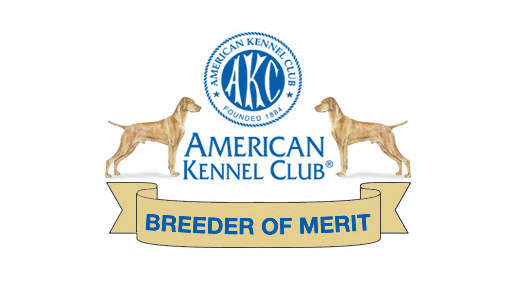
The Vizsla
|
|
|||||||||
|
|
||||||||||
Description
The Standard is the physical "blueprint" of the breed. It describes the physical appearance and other desired qualities of the breed otherwise known as type. Some characteristics, such as size, coat quality, and movement, are based on the original (or current) function for the dog. Other characteristics are more cosmetic such as eye color; but taken together they set this breed apart from all others.
The Standard describes an ideal representative of the breed. No individual dog is perfect, but the Standard provides an ideal for the breeder to strive towards.
Characteristics and Temperament
Vizslas are very friendly, affectionate, loyal dogs that make wonderful family pets and hunting dogs. They need to be treated like a member of the family, preferring to sleep inside and being close to their people. Most Vizslas are lap dogs - with males weighing 50 to 60 pounds and females 40 to 50 pounds - be prepared! They do not make good "kennel" dogs. They should be active, but not hyper. They require daily exercise and will get into mischief if bored. Vizslas are very easy to train, being both intelligent and eager to please. They are sensitive and should not be severely disciplined, but are not "soft." Vizslas love warmth and are frequently found basking in the sun.
Vizslas are outstanding hunters and will both point and retrieve. They have very sensitive noses, good eyesight and a natural enthusiasm for the hunt. It's fantastic to watch a Vizsla lock up on point - it's hard to find words to express their grace, beauty and intensity. Although Vizslas are primarily known for their skill in hunting upland game birds such as pheasant, quail and grouse, they are also used for hunting waterfowl and even small fur animals. Most Vizslas are strong swimmers and should be introduced to water when they're young.
Vizslas have beautiful, soft, rust-colored coats that require very little
maintenance. They do shed, which especially shows up against black clothes.
They're clean dogs and have very little odor. There is a wirehaired Vizsla, more
common in
Vizslas are commonly known by their owners as "velcro-dogs". They are very touch-oriented and prefer to be in contact with their people at all times. They will accompany their people everywhere, including into the bathroom and shower. If you do not appreciate constant canine companionship, the Vizsla is not the dog for you.
Health
In general, Vizslas are an extremely healthy breed and it is common for them to have a life span of over 14 years.
Some Vizslas are prone to skin and/or food allergies. They can be sensitive to anesthesia used during surgeries and it is recommended that owners consult their veterinarian regarding the use of a special anesthesia, such as isofluorine gas, during surgery. Vizslas may be sensitive to other drugs as well, consult your veterinarian for more information.
Vizslas are susceptible to hip dysplasia, although careful breeding has kept this problem to a minimum in the breed. All Vizslas that are going to be bred should be x-rayed and certified clear of hip dysplasia by the OFA (Orthopedic Foundation for Animals). X-rays must be taken after the age of 24 months, when a definitive diagnosis can be made. If you are purchasing a puppy, make sure that both parents have been OFA certified.
Less common genetic diseases in Vizslas include hemophilia, von Willebrand's Disease, tail defects, and epilepsy.

|
|
|||||||||
|
|
||||||||||
|
|
|||||||||
|
|
||||||||||
|
|
|||||||||
|
|
||||||||||
|
|
|||||||||
|
|
||||||||||
|
|
|||||||||
|
|
||||||||||
|
|
|||||||||
|
|
||||||||||
|
|
|||||||||
|
|
||||||||||